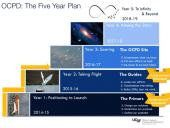The OCPD developed a five year strategic plan with the intention of bringing the OCPD's services, programs, initiatives, and resources inline with the office's vision and core mission statement, and consolidating efforts around priority goals. The OCPD's overall plan is composed of the the individual strategic plans developed by each Program Director, which is referred to as a Primer.
The OCPD's strategic planning process addresses four key themes:
While the value of career services and professional skill development for graduate and health professional students and postdoctoral scholars is increasingly recognized, there is not a consensus around which topics career and professional development staff should prioritize. Based on stakeholder feedback, the OCPD took three steps:
- Defined a broad set of professional competencies beneficial for students and postdocs seeking to manage their careers
- Catalogued and organized career and professional development offerings across UCSF offered by the four schools, the Graduate Division, fellow student service units, professional development offered by fellow UCSF entities (e.g., the Alumni Association, the Entrepreneurship Center), and registered campus organizations (e.g., the Consulting Club, Women in Life Sciences, etc.)
- Prioritized topics that were identified as gaps in the career and professional development offerings at the university
2. What is the scope of career and professional development topics OCPD addresses? Which interventions should be implemented, and when should they be offered?
In considering timing and various approaches to offering career and professional development, the OCPD bases its decisions on the principle that adult learners, “...learn best when the topic is of immediate value”. Programs, resources and services are designed to sync with moments when trainees are open to or prioritizing their career and professional development. Examples of this intention include targeting the MIND and GSICE programs (a peer-group career exploration initiative and an internship program, respectively) to second year graduate students. This decision is based on C.N. Fuhrmann's, et al. work, which identified that life science trainees show an increased interest in non-academic career options around their second year. Another moment when trainees are prioritizing career decisions is centered around family. The OCPD offers an Interviewing While Pregnant workshop quarterly, in order to offer this workshop to trainees early in their pregnancy throughout the year.
3. What skills, knowledge and support are essential for staff to succeed?
NACE and the NIH have both noted the increased scope of competencies required for career services practitioners to function in their role and effectively serve students and postdoctoral scholars. In the OCPD, in addition to content knowledge expertise, each Program Director’s job description includes strategic planning, program development, 1:1 counseling, resource development, potentially supervision, and evaluation responsibilities. The OCPD launched a series initiatives to support staff. In addition to being considered OCPD's best practices for staff productivity and satisfaction, all of these efforts are inline with the university's ongoing employee engagement survey, administered by Gallup (see slide #3 for details).
4. What are meaningful metrics to determine OCPD's success in achieving it's mission?
The OCPD is consciously moving away from the focus on utilization and satisfaction, towards evidence of impact as key assessment metrics. To read more about OCPD’s assessment efforts, please visit the Program Design and our Research, Assessment and Dissemination sections.

